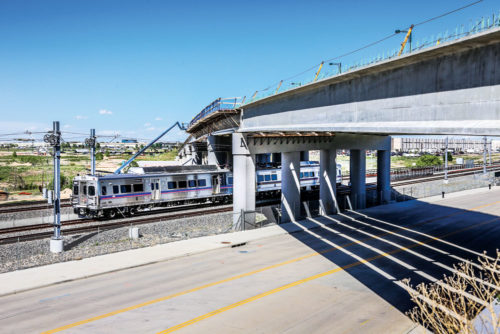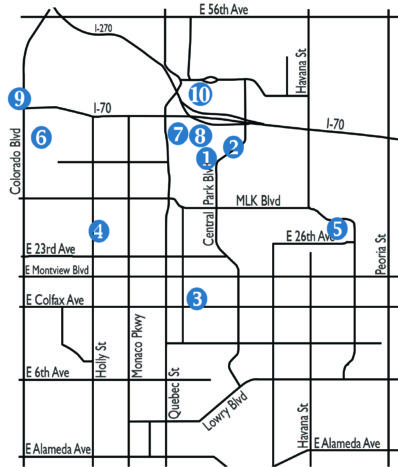1.) What’s happening with the Sprouts by Central Park Station? And other upcoming development?
- Forest City Senior Vice President Jim Chrisman provided the following development information at the May 15 annual SUN (Stapleton United Neighbors) meeting:
The property sale to David Friedman near the Central Park Station (36th and Uinta), which will include Sprouts, is scheduled to close May 31. Chrisman estimated construction could start within a month. In addition to Sprouts, that project will include about 12,000 square feet of retail and 130 one- and two-bedroom condos priced from about $300,000 to $500,000. For information on this project visit FrontPorchNE.com and search for Sprouts. - A one-acre lot on the northwest corner of Montview and Central Park Blvd. is under contract to a developer who will build small retail that will include a Starbucks. It is scheduled to close in December so construction will likely start in early 2019.
2.) A Line to close June 23-25 for bridge construction

The Central Park bridge was closed from 3am, Saturday, April 28 until 3am April 30. This photo was taken at 3:30am April 28 showing the cranes needed to install the girder.
Construction work on the Central Park Bridge project will disrupt service on the entire A Line on Saturday, June 23 starting at 2pm and ending Monday, June 25, at 3am, according to RTD communications office. Information about the closure will be posted at www.rtd-denver.com.
3.) Is urban renewal coming to East Colfax?
Denver Urban Renewal Authority (DURA) is conducting a blight study along East Colfax from Colorado Blvd. to Yosemite, the necessary first step in determining whether the area qualifies for tax increment financing (TIF). DURA sent a letter to property owners informing them that the study will be done and met with them at a public meeting on May 10 at Johnson and Wales.
TIF financing is considered when redevelopment is not feasible for the private sector to accomplish on its own. The blight study determines if the area qualifies for TIF financing and sets the boundaries of the area that qualifies for TIF. Under TIF financing, the tax base before improvements is determined, and that base tax revenue goes to that area’s usual taxing authorities. As the area gets redeveloped and property values increase, the additional tax revenue over and beyond the base amount goes into a fund overseen by DURA and is used to pay for redevelopment expenses.
We will follow up with the outcome of the blight study.
4.) Will there be an innovation zone for some of the northeast area schools?
Swigert International School, McAuliffe International School, McAuliffe at Manual and Northfield High School have applied to create an Innovation Zone within the Denver Public School system. An Innovation Zone operates in the “space between the charter sector and the district operator,” according to DPS, which allows greater financial flexibility and promotes close collaboration among participating schools.
The four schools applying to create a new Innovation Zone are seeking to create an International Baccalaureate-focused vertical alignment, overseen by a board of directors, but still held accountable to state and local standards. Teachers at the four schools have already voted to approve the plan. After the schools present to the DPS Board of Education on June 11, the Board will vote on the plan’s approval June 14.
5.) Who is the new Izzi B principal?
Veteran teacher and administrator, Lisa Schuba, has been named the new principal for Isabella Bird Community School (Izzi B), according to a letter from DPS Instructional Superintendent Monica Nurrenbern. Schuba has been a principal at the Boulder Valley School District and in Durango, in addition to having 18 years of teaching experience. Assistant Principal Laura Glaab, who had also sought the principal position, will remain in her current role at Izzi B, helping to ease Schuba’s transition, according to the May 11 DPS letter.
In a letter to the community, Schuba noted her connection to Izzi B founding leader, Sonny Zinn, whom she cited as an “unofficial mentor.” She also expressed excitement at joining the school, which is “on the forefront of innovation and school reform.” Schuba began spending time at Izzi B during the final weeks of school while continuing her work in Boulder. Principal Brian Ricker, who had led the school for two years, stepped down in April.
7.) What’s happening at Park Hill Golf Course?
Arcis Golf, which leases the Park Hill Golf Course from Clayton Early Learning, has a clause in the lease that gives them the first right of refusal to purchase the land. On April 24, Arcis Golf, filed a lawsuit claiming Clayton had failed to honor that clause. The lawsuit states the Clayton Trust and the City drafted a purchase and sale agreement and made a public announcement about it—actions that show it was a bond fide offer. Arcis is asking for an order from the court allowing them to purchase the Park Hill Golf Course land on the same terms as were in that offer. The Trust says it was not a bona fide offer, as is required by the terms of the lease. Brantley says a court date has not yet been set.
The golf course land carries a “conservation easement” that requires the land be used only for a golf course, and that restriction would be passed on to a buyer. The only way to change or remove that requirement would be through a vote of the City Council, according to Charlotte Brantley, president and CEO of Clayton Early Learning.
Separate from the lawsuit, the terms of Arcis’ current lease, which extends through the end of 2018, requires that Arcis inform Clayton by June 30 if they choose to renew their lease for five years starting January 2019.
Brantley is continuing to hold public meetings to hear what the community thinks should happen to the golf course land in the future. The next meeting will be held in July.
City Council voted in January to pursue acquisition of up to 90 acres of Park Hill Golf Course land as a permanent stormwater detention area that will temporarily hold and slow floodwaters. The entire golf course is likely to be closed for a year beginning January 2019 with approximately nine months of construction time, according to Nancy Kuhn of Denver Public Works. The city has money in its budget to restore the land as a golf course when construction is finished.
Design of the detention area on the Park Hill Golf Course property will be getting underway in the second half of 2018. There will be a public process as part of design development
7.) How is RTD dealing with train delays?

A photo taken of an A line train passing under the bridge less than a month after the closure shows the additional lane added to the bridge.
Scott Reed from RTD communications emailed in response to our question: “RTD has now implemented a much more comprehensive audit and review process to help ensure that DTP’s internal operating procedures, response plans and employee training are appropriate and proper to continually meet the high standards of RTD and our customers.”
8.) Is there any progress toward a quiet zone on the A Line?
“We are continuing final testing of the grade crossing technology on the University of Colorado A Line in partnership with Colorado Public Utilities Commission staff. We are nearly complete with those tests and will then await approvals from the PUC. Those final PUC approvals will permit the removal of the flaggers as well as consideration by the Federal Railroad Administration of the applications for establishing quite zones along the CU A Line. All of the communities along the A Line have filed applications for quiet zones,” said Scott Reed of RTD communications via email.
9.) When will I-70 construction begin?
Reconstruction of the 10-mile Central 70 Project is set to begin this summer. Commuters will see construction crews all along the corridor as the contractor team works to widen I-70 and rebuild several major interchanges between Chambers Road and Brighton Blvd. The I-70 viaduct will remain in place until 2020 as initial excavation of the lowered highway between Brighton and Colorado boulevards will occur north of existing I-70. Additional early construction activities include: rebuilding the I-270/I-70 overpass (the new bridge will be constructed adjacent to the existing structure so minimal traffic impacts are expected); relocating various utilities; and constructing a railroad bridge requiring a permanent closure of 46th Avenue between Brighton Blvd. and York St. To stay updated on traffic impacts, please visit c70.codot.gov and email us at central70info@state.co.us to sign up for updates.
I-70 update provided by CIG, which provides public information for Colorado Department of Transportation (CDOT).
10.) What’s happening with future drilling in Stapleton?
At the Stapleton United Neighbors (SUN) meeting held on May 15, Assistant City Attorney Jessica Brody announced that she is the new local government designee (LGD) for the Colorado Oil and Gas Conservation Commission. If the State Land Board (SLB) or any other entity seeks to lease mineral rights under properties in Denver, Brody would be notified and, in turn, would notify affected registered neighborhood organizations.
Brody informed attendees about mineral rights ownership in Stapleton. “In general, the City and County of Denver used to own most of the mineral rights on property that we previously owned when it was part of the airport,” she said. “Those mineral rights have been transferred to Forest City.”
Tom Gleason of Forest City confirmed the developer’s ownership and intentions at the meeting. “When we (Forest City) buy land here, if there are mineral rights associated with that property, we get ownership of those mineral rights,” said Gleason. “Bottom line is we do not want those mineral rights developed.” Gleason also added, “We will not convey them to someone who might buy the land, say a commercial developer, because we do not want those mineral rights developed.”
Gleason, in an email to a Stapleton resident, noted that since Forest City doesn’t intend to develop any mineral rights, it has not “spent any time or money determining whether or not those rights exist” and so cannot confirm its ownership of mineral rights under specific parcels.
Brody noted that there are regulations in the city and the state about setbacks and locations for drilling to protect residential neighborhoods. Brody did acknowledge that innovations in horizontal drilling technology could lead to attempts to drill miles underneath to access oil and gas stores from remote sites, however.
In January, the SLB was considering an application to auction a lease for mineral rights under portions of north Stapleton controlled by the SLB. The LGD for the City failed to notify affected neighbors at that time. Fortunately grass-roots social media efforts and SUN organizing contributed to the defeat of the auction proposal, putting it out of consideration for two more years. See the February edition of the Front Porch for more detail on those events.




0 Comments